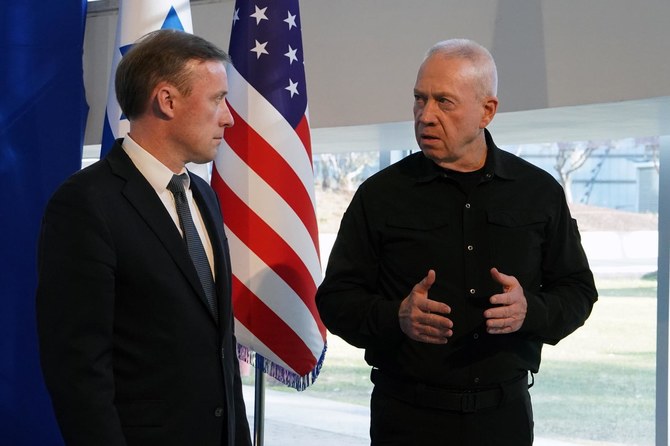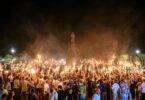Faisal J. Abbas
As the atrocities continue to unfold in Gaza, we hear so much talk now about “the day after” scenarios. This is paired with interesting statements recently made by the likes of US National Security Adviser Jake Sullivan indicating the start of a deviation from the hard-line earlier position of his administration, when President Joe Biden said there were no red lines for Israel.
Clearly, such a position by President Biden was not surprising ahead of an election year. However, that, accompanied by the much-criticized veto of a resolution calling for a ceasefire in the UN Security Council, has now resulted in more than 18,500 killed by Israel, including babies, women, the elderly and at least 56 journalists.
So, what do Sullivan’s statements mean? Firstly, that despite the carefully selected public phrases, it is clear that the global outrage of what is happening in Gaza has caused serious concerns behind closed doors in the US and Israel. This is why it is somewhat reassuring to hear someone as senior and experienced as Sullivan say that his recent talks with Israeli officials were about transitioning to a new phase of the war targeting Hamas in particular. He reiterated that Hamas is not the Palestinian people and that more needs to be done to ensure Israel’s declared intention not to target civilians reflects the reality on the ground.
More significantly, he said that Israel cannot occupy Gaza in the long run. This brings us back to the ongoing debate about “the day after” scenarios.
First, it is important to remember what Saudi Foreign Minister Prince Faisal bin Farhan said a few days ago about the matter: Any future discussions cannot occur while the bombing continues. So, the attention has to remain on obtaining an immediate ceasefire. And what should be clear is that the — again highly condemnable — US veto should not be seen as the end of the road, but a reminder that more efforts should be made to convince the administration and the international community to put more pressure on Israel. This includes a reworded draft resolution if that is what it takes to resolve the matter.
The bottom line is that the aim should remain focused on an immediate ceasefire and a permanent solution to the conflict by finally reestablishing a Palestinian state living side by side and in peace with Israel.
This is why the obsession with talking about “the day after” must be paired with an equal obsession with talking about “the day before,” and that means the fact that Israel has been occupying Palestinian lands since 1967, as defined by the UN. A matter that must be resolved to ensure what happened on Oct. 7, and before, does not happen again.
Despite the gloomy outlook, there are still glimmers of hope. To start with, the Hamas leadership has signaled its willingness to accept a two-state solution — as suggested by senior Hamas official Mousa Abu Marzouk in a recent interview with Al-Monitor. Of course it is fair for one to argue — or rather wish — that it had done so 16 years ago and supported the Palestinian Authority’s efforts to reach a peace deal instead of undermining it and calling for the eradication of the state of Israel. After all, history shows that more Arab land has been liberated and reclaimed via negotiations as opposed to warfare. Jordan, Egypt and Lebanon are clear and recent examples.
Another sign of hope is the recent successful release of the first group of hostages. This was a reassuring sign that regional diplomacy can work, and it goes without saying that more goodwill gestures like that will go a long way. This is why efforts by countries like Qatar and Egypt must continue to be supported on that front.
However, the question remains: What does “the day after” look like? We must examine all possibilities on the ground. It is clear nobody will accept another Israeli occupation of Gaza when the efforts are on convincing them to dismantle settlements in the West Bank to enable a two-state solution. What is also clear is the Arab/Muslim/Palestinian position — an absolute rejection of any Israeli plan to displace or transfer the people of Gaza elsewhere. Palestinians must and will remain in their land and another Nakba must be avoided.
Similarly, the PA would never accept riding back into Gaza on the backs of Israeli tanks. A transition period with international peace-keeping troops — like the situation in Lebanon — might be possible, but that would require an acceptable formation, most probably with the involvement of neutral international armies and Arab states that have signed peace treaties with Israel.
It is also likely there will be a situation whereby the West Bank and Gaza are reunited under one authority, which essentially goes against the creed Israeli Prime Minister Benjamin Netanyahu has adopted for the past 16 years of widening intra-Palestinian divisions.
The last but probably unlikely possibility is a referendum, which includes all Palestinians, to see whether they want to live in one country alongside Israel. This is likely to be rejected by both sides, particularly as, while it would tick the box of Israel being a democracy, it would end its raison d’etre as a “Jewish state.”
And given that a one-state solution is unlikely, what really does not help at this stage are the statements by Israeli officials, most recently and notably the ones by Israeli ambassador to London, Tzipi Hotovely, categorically rejecting in a televised interview the concept of two states.
What also does not help is the Muslim community shooting the messenger and calling for the boycott of an influential television show like “Piers Morgan Uncensored.”
In fact, what is needed is more appearances by rational guests who can present convincing arguments for justice. Just look at the results achieved by a fair and balanced reporter like CNN’s Clarissa Ward when she was given access, via an Emirati field hospital, to report from Gaza. The truth is very powerful, so I cannot see how anything can be achieved by boycotting the debate, as opposed to owning it.







